Handbook of Mammals of Madagascar
Limited Edition Prints
To mark the publication of my latest book, I am offering a set of eight prints depicting iconic mammals from Madagascar. The prints are all 45cm x 30cm (including white border) and are limited to 100 of each, signed and numbered. They are available individually or as a set of eight.
Per print £50 plus P&P
Set of eight £350 plus P&P
Please email to place an order - nick@nickgarbutt.com
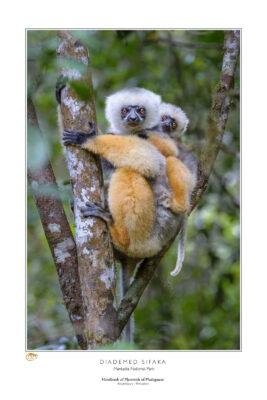
Diademed Sifaka
The books front cover. Arguably the most beautiful of all Madagascar's lemurs, the Diademed Sifaka is second in size only to the Indri. This photo of a mother with an infant approximately three months old was taken in Andasibe-Mantadia National Park.
I had tracked a group of sifakas up and down steep slopes for most of the morning, but had failed to get into a position worthy of a photograph. For the most part, the sifakas stayed high in the canopy or we simply moving too quickly for me to keep up. Then, this female with her baby descended into the understorey and began eating leaves on branches only a couple of meters off the ground. Once they'd finished, they rested on an adjacent branch and I got the picture. The infant was so inquisitive.
Nikon D3s, Nikkor 200-400mm @ f5.6
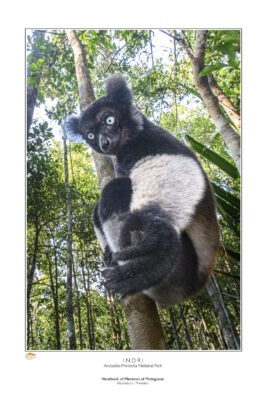 Indri
Indri
The largest of the (living) lemurs, the teddy bear-like Indri is one of Madagascar's best loved mammals. It is most famous for its haunting territorial song, that carries through the canopy of its eastern rainforest home.
This particular Indri lives in the Mitsinjo Forest near Andasibe. He is called David, after Sir David Attenborough, who visited this forest to film Indris a few years ago. David belongs to a group of four animals - Indri always live in family units, parents plus dependent offspring.
Nikon D5, Nikkor 17-35mm @ f11
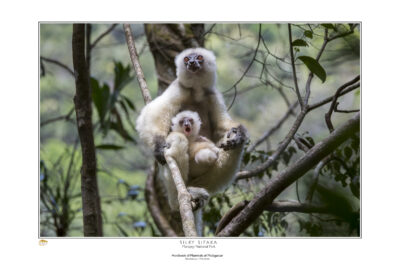
Silky Sifaka
Found only in and around Marojejy National Park and remote adjacent areas, the Silky Sifaka is one of the island's rarest mammals (officially Critically Endangered): there are perhaps fewer than 1000 individuals remaining.
Like all sifakas, they live in multi-male, multi-female groups and occupy territories of around 45ha. The steep slopes and dense tangled understorey make following these animals extremely difficult, so working into position to get a decent photograph takes time and can be exhausting. On my very first visit to Marojejy in 1998, I spent four days in the forest trying to track these animals and managed to get one very poor picture.
This photo of a mother and three to four month old infant was taken many years later, when one group if Silky Sifakas had become more tolerant thanks to a long-term research project. Nonetheless, I recall lung-bursting effort and sweat-drenched clothing to get this shot.
Nikon D5, Nikkor 200-400mm @ f6.3
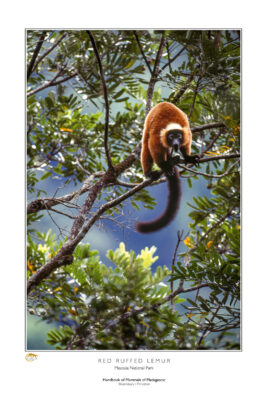
Red Ruffed Lemur
One of two species of ruffed lemur, the Red Ruffed Lemur is found only on the Masoala Peninsula in the far north east of the island. They are specialist high-canopy dwellers and being almost exclusively fruit eaters, very much rely on large fruiting trees that lie at the core of their territories. Such trees are often the first to be removed by humans, which makes these lemurs particularly vulnerable to deforestation.
Red Ruffed Lemurs present considerable challenges to photograph, because they are so often way up in the tree tops. To get this shot, I spent many hours over several days tracking a group of lemurs along a ridge line, as this occasionally allowed me to get eye-level views when the lemurs were at the tops of trees down-slope from me. Such opportunities are rare: this photo is over 20 years old and was taken on film!
Nikon FE2, Nikkor 500mm @ f5.6, Fijichrome Velvia
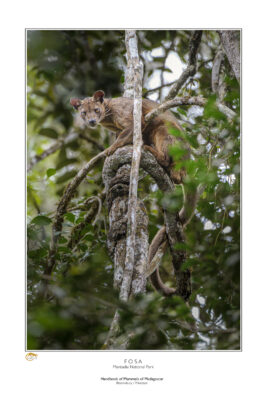 Fosa
Fosa
The spectacular Fosa is Madagascar's largest carnivore. Like all carnivores on the island it belongs to the endemic family Eupleridae (the Malagasy carnivores). However, because of various anatomical and behavioural similarities, the Fosa has previosuly been regarded as a peculiar type of feline or giant mongoose!
Fosas are extremely agile hunters and can pursue their prey - often lemurs - through the tree tops. Recent research has shown that sometimes brothers (from the same litter) join forces to hunt cooperatively which increases their hunting success, especially with larger lemur species like sifakas (this is very similar to cheetahs).
Fosas are never easy to see or photograph. Most encounters occur in the dry forests of western Madagascar. However, this photo of a male was taken in the eastern rainforest of Mantadia National Park: there are precious few photos of Fosas from rainforest regions.
Nikon D3s, Nikkor 200-400mm @ f5.6
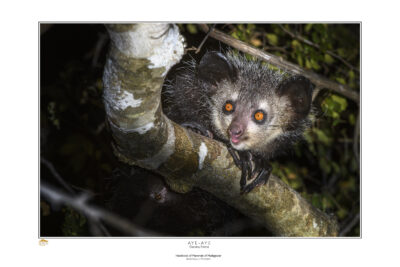 Aye-aye
Aye-aye
On an island full of oddities, the Aye-aye stands out as perhaps the most peculiar of all. When first described in 1788, this exceptional primate was thought to be a weird type of squirrel. All lemurs are now known to have evolved from a single ancestor that colonised Madagascar some 50-60 million years ago. Ancestors of today's Aye-aye's probably formed the first significant offshoot not long after the initial colonisation.
Half a century ago, the Aye-aye was thought to be on the brink of extinction, with fewer than 50 individuals thought to remain in a remote area in the north east. Over the past forty years, as more research has taken place around the island they have been recorded at many different sites and are now known to be the most widely distributed of all lemurs. However, they only ever occur at very low densities and are generally incredibly difficult to observe. This photo was taken in the dry forests near Daraina in the far north.
Nikon D5, Nikkor 200-400mm @ f8
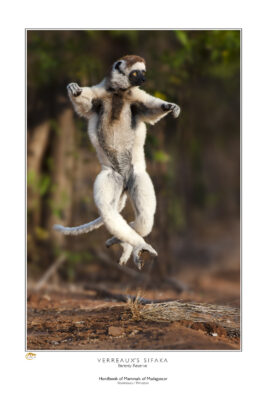
Verreaux's Sifaka
One of the island's most familiar species, the cute and endearing Verreaux's Sifaka is most famous for its slightly awkward and comical 'skipping' or 'dancing' behaviour as it bounds upright across open ground. It is quite likely that all sifaka species are capable of this, but those living in dense rainforest areas rarely encounter the open areas that are more common in some of the drier forest regions inhabited by Verreaux's Sifakas.
This species is also well-known for it onomatopoeic alarm calls - shi-fakh, shi-fakh, shi-fakh - that are often given by agitated individuals.
Verreaux's Sifakas can be found in both western deciduous forests and south spiny forests. In very hot area they are known to 'hug trees' at ground level, which helps keep them cool.
Both of these photos were taken at Berenty Private Reserve in the far south. This is one of the island's most popular wildlife destinations, with easy to see Ring-tailed Lemurs and Verreaux's Sifakas in accessible forest.
Nikon D3, Nikkor 200-400mm @ f5.6
Nikon D3, Nikkor 70-200mm @ f5.6

